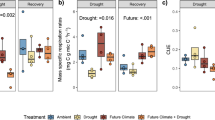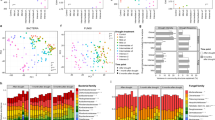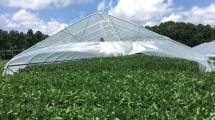Abstract
A large soil CO2 pulse is associated with rewetting soils after the dry summer period under a Mediterranean-type climate, significantly contributing to grasslands’ annual carbon budget. Rapid reactivation of soil heterotrophs and a pulse of available carbon are both required to fuel the CO2 pulse. Understanding of the effects of altered summer precipitation on the metabolic state of indigenous microorganisms may be important in predicting changes in carbon cycling. Here, we investigated the effects of extending winter rainfall into the normally dry summer period on soil microbial response to a controlled rewetting event, by following the present (DNA-based) and potentially active (rRNA-based) soil bacterial and fungal communities in intact soil cores (from a California annual grassland) previously subjected to three different precipitation patterns over 4 months (full summer dry season, extended wet season and absent dry season). Phylogenetic marker genes for bacteria and fungi were sequenced before and after rewetting, and the abundance of these genes and transcripts was measured. After having experienced markedly different antecedent water conditions, the potentially active bacterial communities showed a consistent wet-up response. We found a significant positive relation between the extent of change in the structure of the potentially active bacterial community and the magnitude of the CO2 pulse upon rewetting dry soils. We suggest that the duration of severe dry summer conditions characteristic of the Mediterranean climate is important in conditioning the response potential of the soil microbial community to wet-up as well as in framing the magnitude of the associated CO2 pulse.
Similar content being viewed by others
Log in or create a free account to read this content
Gain free access to this article, as well as selected content from this journal and more on nature.com
or
Accession codes
References
Anderson MJ . (2001). A new method for non-parametric multivariate analysis of variance. Austral Ecol 26: 32–46.
Angel R, Conrad R . (2013). Elucidating the microbial resuscitation cascade in biological soil crusts following a simulated rain event. Environ Microbiol 15: 2799–2815.
Bapiri A, Bååth E, Rousk J . (2010). Drying–rewetting cycles affect fungal and bacterial growth differently in an arable soil. Microb Ecol 60: 419–428.
Barnard RL, Osborne CA, Firestone MK . (2013). Responses of soil bacterial and fungal communities to extreme desiccation and rewetting. ISME J 7: 2229–2241.
Bates ST, Garcia-Pichel F . (2009). A culture-independent study of free-living fungi in biological soil crusts of the Colorado Plateau: their diversity and relative contribution to microbial biomass. Environ Microbiol 11: 56–67.
Birch HF . (1958). The effect of soil drying on humus decomposition and nitrogen availability. Plant Soil 10: 9–31.
Blazewicz SJ, Barnard RL, Daly RA, Firestone MK . (2013). Evaluating rRNA as an indicator of microbial activity in environmental communities: limitations and uses. ISME J 7: 2061–2068.
Blazewicz SJ, Schwartz E, Firestone MK . (2014). Growth and death of bacteria and fungi underlie rainfall-induced carbon dioxide pulses from seasonally dried soil. Ecology 95: 1162–1172.
Boot CM . (2011). Microbial response to drying and rewetting: osmotic and matric effects. Plant Soil 348: 99–102.
Borken W, Matzner E . (2009). Reappraisal of drying and wetting effects on C and N mineralization and fluxes in soils. Global Change Biol 15: 808–824.
Bouskill NJ, Lim HC, Borglin S, Salve R, Wood TE, Silver WL et al. (2012). Pre-exposure to drought increases the resistance of tropical forest soil bacterial communities to extended drought. ISME J 7: 384–394.
Brodie E, Edwards S, Clipson N . (2002). Bacterial community dynamics across a floristic gradient in a temperate upland grassland ecosystem. Microb Ecol 44: 260–270.
Cable JM, Ogle K, Williams DG, Weltzin JF, Huxman TE . (2008). Soil texture drives responses of soil respiration to precipitation pulses in the Sonoran desert: implications for climate change. Ecosystems 11: 961–979.
Cruz-Martinez K, Suttle KB, Brodie EL, Power ME, Andersen GL, Banfield JF . (2009). Despite strong seasonal responses, soil microbial consortia are more resilient to long-term changes in rainfall than overlying grassland. ISME J 3: 738–744.
de Vries FT, Liiri ME, Bjornlund L, Bowker MA, Christensen S, Setala HM et al. (2012a). Land use alters the resistance and resilience of soil food webs to drought. Nat Climate Change 2: 276–280.
de Vries FT, Liiri ME, Bjornlund L, Setala HM, Christensen S, Bardgett RD . (2012b). Legacy effects of drought on plant growth and the soil food web. Oecologia 170: 821–833.
Edgar RC . (2010). Search and clustering orders of magnitude faster than BLAST. Bioinformatics 26: 2460–2461.
Evans SE, Wallenstein MD, Burke IC . (2014). Is bacterial moisture niche a good predictor of shifts in community composition under long-term drought? Ecology 95: 110–122.
Evans SE, Wallenstein MD . (2012). Soil microbial community response to drying and rewetting stress: does historical precipitation regime matter? Biogeochemistry 109: 101–116.
Evans SE, Wallenstein MD . (2013). Climate change alters ecological strategies of soil bacteria. Ecol Lett 17: 155–164.
Field CB, Daily GC, Davis FW, Gaines S, Matson PA, Melack J et al. (1999) Confronting climate change in California: ecological impacts on the golden state. Union of Concerned Scientists, Cambridge, MA and Ecological Society of America: Washington, DC.
Fierer N, Jackson JA, Vilgalys R, Jackson RB . (2005). Assessment of soil microbial community structure by use of taxon-specific quantitative PCR assays. Appl Environ Microbiol 71: 4117–4120.
Fierer N, Schimel JP, Holden PA . (2003). Influence of drying-rewetting frequency on soil bacterial community structure. Microb Ecol 45: 63–71.
Fierer N, Schimel JP . (2002). Effects of drying-rewetting frequency on soil carbon and nitrogen transformations. Soil Biol Biochem 34: 777–787.
Fierer N, Schimel JP . (2003). A proposed mechanism for the pulse in carbon dioxide production commonly observed following the rapid rewetting of a dry soil. Soil Sci Soc Am J 67: 798–805.
Griffiths RI, Whiteley AS, O'Donnell AG, Bailey MJ . (2000). Rapid method for coextraction of DNA and RNA from natural environments for analysis of ribosomal DNA- and rRNA-based microbial community composition. Appl Environ Microbiol 66: 5488–5491.
Göransson H, Godbold DL, Jones DL, Rousk J . (2013). Bacterial growth and respiration responses upon rewetting dry forest soils: Impact of drought-legacy. Soil Biol Biochem 57: 477–486.
Hamady M, Lozupone C, Knight R . (2010). Fast UniFrac: facilitating high-throughput phylogenetic analyses of microbial communities including analysis of pyrosequencing and PhyloChip data. ISME J 4: 17–27.
Inglima I, Alberti G, Bertolini T, Vaccari FP, Gioli B, Miglietta F et al. (2009). Precipitation pulses enhance respiration of Mediterranean ecosystems: the balance between organic and inorganic components of increased soil CO2 efflux. Global Change Biol 15: 1289–1301.
Jarvis P, Rey A, Petsikos C, Wingate L, Rayment M, Pereira J et al. (2007). Drying and wetting of Mediterranean soils stimulates decomposition and carbon dioxide emission: the ‘Birch effect’. Tree Physiol 27: 929–940.
Jones SE, Lennon JT . (2010). Dormancy contributes to the maintenance of microbial diversity. Proc Natl Acad Sci USA 107: 5881–5886.
Kakumanu ML, Cantrell CL, Williams MA . (2013). Microbial community response to varying magnitudes of desiccation in soil: a test of the osmolyte accumulation hypothesis. Soil Biol Biochem 57: 644–653.
Kemnitz D, Kolb S, Conrad R . (2005). Phenotypic characterization of Rice Cluster III archaea without prior isolation by applying quantitative polymerase chain reaction to an enrichment culture. Environ Microbiol 7: 553–565.
Kunin V, Hugenholtz P . (2010). PyroTagger: A fast, accurate pipeline for analysis of rRNA amplicon pyrosequence data. Open J Available at: http://www.theopenjournal.org/toj_articles/1.
Miller AE, Schimel JP, Meixner T, Sickman JO, Melack JM . (2005). Episodic rewetting enhances carbon and nitrogen release from chaparral soils. Soil Biol Biochem 37: 2195–2204.
Parker SS, Schimel JP . (2011). Soil nitrogen availability and transformations differ between the summer and the growing season in a California grassland. Appl Soil Ecol 48: 185–192.
Placella SA, Brodie EL, Firestone MK . (2012). Rainfall-induced carbon dioxide pulses result from sequential resuscitation of phylogenetically clustered microbial groups. Proc Natl Acad Sci USA 109: 10931–10936.
Price MN, Dehal PS, Arkin AP . (2009). FastTree: Computing large minimum-evolution trees with profiles instead of a distance matrix. Mol Biol Evol 26: 1641–1650.
R Development Core Team. (2012). R: A language and environment for statistical computing: Vienna, Austria. ISBN 3-900051-07-0, URL http://www.R-project.org/.
Schippers A, Neretin LN, Kallmeyer J, Ferdelmna TG, Cragg BA, Parkes RJ et al. (2005). Prokaryotic cells of the deep sub-seafloor biosphere identified as living bacteria. Nature 433: 861–864.
Silkie SS, Nelson KL . (2009). Concentrations of host-specific and generic fecal markers measured by quantitative PCR in raw sewage and fresh animal feces. Water Res 43: 4860–4871.
Suttle KB, Thomsen MA, Power ME . (2007). Species interactions reverse grassland responses to changing climate. Science 315: 640–642.
Tokunaga TK, Olson KR, Wan JM . (2003). Moisture characteristics of Hanford gravels: bulk, grain-surface, and intragranular components. Vadose Zone J 2: 322–329.
Waldrop MP, Firestone MK . (2006a). Seasonal dynamics of microbial community composition and function in oak canopy and open grassland soils. Microb Ecol 52: 470–479.
Waldrop MP, Firestone MK . (2006b). Response of microbial community composition and function to soil climate change. Microb Ecol 52: 716–724.
Xiang S-R, Doyle A, Holden PA, Schimel JP . (2008). Drying and rewetting effects on C and N mineralization and microbial activity in surface and subsurface California grassland soils. Soil Biol Biochem 40: 2281–2289.
Xu L, Baldocchi DD, Tang J . (2004). How soil moisture, rain pulses, and growth alter the response of ecosystem respiration to temperature. Global Biogeochem Cy 18: GB4002.
Acknowledgements
We thank Maria Patanwala for nucleic acid extractions, James Cleaver for help in the field, Barbara Rotz for help in the greenhouse, Pascal Niklaus for statistical advice, Chris Jones for help with processing sequencing data and Laurent Philippot for constructive comments on the manuscript. This work was funded by the Kearney Soil Science Foundation. RB was funded by the European Community’s Seventh Framework Programme under grant agreement PIOF-GA-2008-219357.
Author information
Authors and Affiliations
Corresponding author
Ethics declarations
Competing interests
The authors declare no conflict of interest.
Additional information
Supplementary Information accompanies this paper on The ISME Journal website
Supplementary information
Rights and permissions
About this article
Cite this article
Barnard, R., Osborne, C. & Firestone, M. Changing precipitation pattern alters soil microbial community response to wet-up under a Mediterranean-type climate. ISME J 9, 946–957 (2015). https://doi.org/10.1038/ismej.2014.192
Received:
Revised:
Accepted:
Published:
Issue date:
DOI: https://doi.org/10.1038/ismej.2014.192
This article is cited by
-
Dependence of cumulative CO2 emission and microbial diversity on the wetting intensity in drying-rewetting cycles in agriculture soil on the Loess Plateau
Soil Ecology Letters (2023)
-
Bringing Antarctica to the lab: a polar desert environmental chamber to study the response of Antarctic microbial communities to climate change
Polar Biology (2023)
-
Asynchronous responses of microbial CAZymes genes and the net CO2 exchange in alpine peatland following 5 years of continuous extreme drought events
ISME Communications (2022)
-
Intensive grassland management disrupts below-ground multi-trophic resource transfer in response to drought
Nature Communications (2022)
-
Repeated drying and rewetting cycles accelerate bacterial growth recovery after rewetting
Biology and Fertility of Soils (2022)



